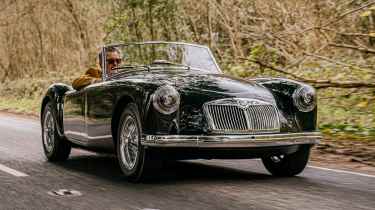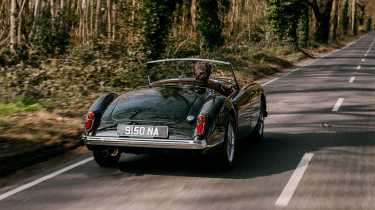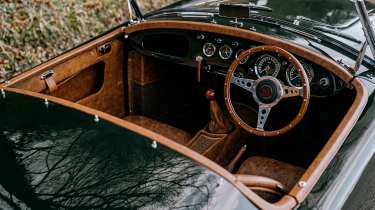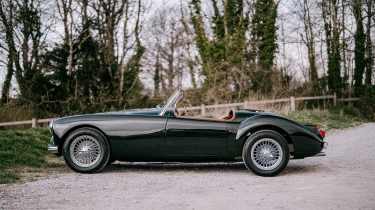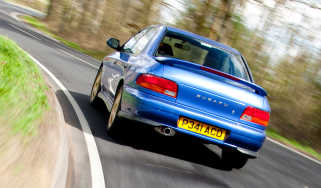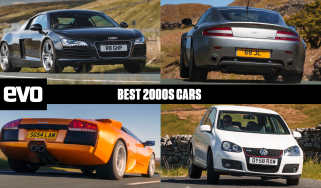Frontline MGA Factory Edition review – a quaint classic with a modern heart
The MGB restomod specialist turns its attention to the B’s pretty predecessor. The result is compelling
Pretty, isn’t it? The MGA is 70 years old in 2025, and it looks as lovely as ever. Technologically, however, it’s very much a car from the 1950s, leaf springs and all.
Unless it has been reworked by Frontline Cars. The Abingdon-based MG specialist has made its name both restoring and modernising MGBs into surprisingly potent packages over the last 34 years. (We drove two examples, the V8 LE60 and electric-powered BEE GT, in evo 316.) Now, for the first time, it’s turned its hand to the B’s predecessor too. This customer car is Frontline’s first ‘Factory Edition’ MGA, and while its looks remain faithful to its origins, the underpinnings are very much 21st century.
It is offered with the choice of a 2- or 2.5-litre Ford Duratec engine, the former with 225bhp and 178lb ft of torque, the latter offering 290bhp and 243lb ft. Both units are naturally aspirated and matched to a five-speed Mazda MX-5 gearbox, while a limited-slip differential is also fitted. Disc brakes are present at each corner – four-piston items at the front, two-piston at the rear – and the A’s fly-off handbrake remains. There’s also electric power steering with alterable levels of assistance, and adjustable Nitron suspension with a five-link rear layout replacing the original leaf-spring set-up. The front axle, with telescopic dampers, is a development of the kit Frontline has supplied to more than 2000 MGs since 2005.
More reviews
Group tests
- Alpine A290 v Alpine A110 – how much DNA do they really share?
- Ariel Atom 4R v Caterham Seven ‘evo25’: power-to-weight heroes go head-to-head
- Ariel Atom 4 v Caterham Seven 310R v Lotus Elise Cup 250
- £200,000 supercar shoot-out: AMG v Aston Martin v Maserati v McLaren
- Who makes the best GT car? Aston Martin v Bentley v Maserati
- Caterham Super Seven 600 v Super Seven 2000
- Corvette Stingray v Porsche Cayman GTS v Audi R8 RWD
- Volkswagen Golf GTI Clubsport v Cupra Leon 300 – what's the best mainstream hot hatch?
- Great Ferrari hypercars driven: 288 GTO, F40, F50 and Enzo head-to-head
- GMA T.50 v McLaren F1 – has the best car in the world been dethroned by its successor?
In-depth reviews
- Abarth 600e 2025 review – Italy gives the Alpine A290 something to worry about
- Alpine A110 2025 review – an all-time great sports car living on borrowed time
- Aston Martin Vantage 2025 review – a thrilling Mercedes-AMG GT and 911 Turbo S alternative
- Audi R8 (2015 - 2024) review – the ultimate soft-focus supercar
- BMW iX 2025 review – the ugly duckling still stomps the Tesla Model X
Long term tests
- Abarth 695C Turismo Fast Fleet test – 10,000 miles in the Italian hot hatch
- Alfa Romeo Giulia Veloce Fast Fleet test – living with the sharp Italian saloon
- Alpina B10: end of term report
- Alpina B10
- Aston Martin Vantage (2006) Fast Fleet test – living with a £30k V8 Aston
- Caterham Seven evo25 Fast Fleet test – living with a track car for the road
- Caterham Seven evo Edition revealed – bespoke 420R joins the Fast Fleet
- Cupra Leon Estate 310 4Drive Fast Fleet test – living with the 306bhp hot estate
- Ford Mustang GT
- Ford Mustang GT
Review
- New Bentley Batur 2023 review – can it possibly be worth £1.65m?
- 2023 Chevrolet Corvette C8 Z06 review – the American 911 GT3?
- BBR Supercharged Mazda MX-5 (ND) 2023 review – tuned 250bhp roadster driven
- MG4 Trophy 2023 review
Reviews
- Abarth 695 75 Anniversario edition 2024 review – a fitting send-off for Abarth’s hot supermini?
- Abarth 500e 2023 review
- AC Cobra 378 Superblower MkIV 2021 review – another V8 Cobra, but with a GM heart this time
- Acura Integra Type S 2024 review – a Honda Civic Type R with added restraint
- Alfa Romeo Giulia 2025 review – get one while you still can
- Alfa Romeo 33 Stradale 2025 review – a rare Italian jewel beyond compare
- Alfa Romeo SZ: history, review and specs of an icon
Whereas Frontline’s Factory Edition MGBs use brand-new bodyshells, there is no such equivalent available for the MGA, so a donor car’s body must be fully restored in-house. Shutlines are re-set, blemishes removed, bumpers deleted or re-chromed according to taste. In the process, the body is stiffened and its weight reduced, contributing to the Factory Edition weighing only 815kg in its lightest spec, despite 17kg of sound insulation being added (although that’s a dry weight rather than with fluids).
New LED light units are fitted, with integrated indicators, and the original sidelights removed. Otherwise, externally, it looks very much like the original MGA; a wolf in Old English Sheepdog’s clothing. There’s a choice of 15-inch wire wheels or Dunlop-style alloys, with modern Continental or Bridgestone tyres.
The interior too is sensitively reworked. There’s upgraded heating and ventilation, Frontline-branded dials, and the option of a stereo (with smartphone compatibility) that’s hidden from sight. Two USB ports are neatly integrated too. This car has Frontline’s optional alloy tub seats, which look great and are more comfortable and supportive than they appear, and can be heated too, though in true classic-car style the seatbelt keeps slipping off my shoulder. The driver’s seat in this particular car doesn’t adjust – Frontline fits each car to its owner, but it also offers seats on runners if the customer prefers. You can even have electric windows if the donor MGA is a coupe. Everything you touch feels expensively finished and perfectly weighted.
Customers can spec their cars however they wish: exterior colour, interior colours and materials; Alcantara, leather (four hides go into a full leather interior) and many other options besides. Although there is a set Factory Edition spec, bespoke commissions can be taken too. The company would be happy to do a Sebring-style racer with louvred bonnet and cut-down Perspex screen, for example.
The new engine is much lighter than the B-series block in the original, and whether you go for the 2- or 2.5-litre version, it’s fitted with individual throttle bodies, bespoke camshafts, a specific ECU calibration and a stainless-steel exhaust system. There seems little point in choosing the bigger engine: the 2-litre, as driven here, is still 153bhp more powerful than the original MGA 1500, and makes this a rapid little car: 0-60mph takes 4.8sec, and a top speed of 155mph is claimed.
Revs pick up quickly and cleanly; throttle blips are responsive, and addictive. The Mazda gearbox is smooth enough that you don’t need to blip the throttle on every downshift, but it’s hard to resist. In fact, the Factory Edition requires some self-restraint in general. It’s not uncommon to glance at the speedo and realise you’re travelling faster than expected, or intended. This particular car has relatively tall gearing, and a shorter axle ratio can be fitted instead, but the light weight makes light work of it. Its pace could surprise a few modern performance cars.
The power-to-grip ratio feels nicely balanced, and there’s just enough of everything. The suspension is relatively firm at the back but its movements are well controlled and handling is predictable at regular road speeds. The locking diff works well, too, I can report from a couple of experimental laps of a quiet roundabout. Despite its appearance, there’s something about the Factory Edition that eggs you on.
The power steering is relatively quick, without a particularly strong self-centring effect. You can argue as to whether such a lightweight car really needs power steering, but it does make the Factory Edition very easy to drive. It’s not too physical an experience but it is a sensory one. And exploring narrow rural roads, the MGA’s compact dimensions are a boon. It’s a reminder that smaller dimensions often make for more enjoyable cars on British roads. Besides the UK, the Factory Edition is also offered to Europe, Australia and the USA.
Which brings us to the price. The combination of painstaking restoration and reengineering, high-end parts and materials and plenty of labour hours, all for a car built in low volume and therefore without the benefits of economies of scale, means this was unlikely to be a cheap product. And the depth of quality of the finished product justifies its price (which can vary according to each customer’s chosen spec). Nonetheless, I feel like a doctor delivering bad news to tell you that the MGA Factory Edition in its recommended baseline spec costs around £145,000. Plus tax. In addition to sourcing a donor MGA.
Getting lost on sunny B-roads in this vintage car built to 21st-century standards is a pretty wonderful way to spend time. Sadly, it can’t be spent at 1950s prices.
